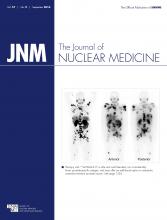Nearly 100 y ago, Ivan Pavlov presented the most famous example of classic conditioning, which occurs when a conditioned stimulus is paired with an unconditioned stimulus. Usually, the conditioned stimulus is a neutral (e.g., the sound of a tuning fork) and the unconditioned stimulus is biologically potent (e.g., food) and produces an unconditioned response (e.g., salivation). In anxiety disorders, such as posttraumatic stress disorder (PTSD), a trauma can be considered an unconditioned stimulus; this type of conditioned fear fails to extinguish, and reminders of traumatic events can cause pathologic conditioned fear responses for decades after danger has passed (1). PTSD affects up to 40% of individuals with over-lifetime exposure to traumatic events (2,3). Over the past decade, there has been a surge of interest in the experimental extinction of fear for its own sake. Beyond the interest in the basic mechanisms of learning and memory, this renewed interest in fear extinction is due in large part to the clinical significance of this extinction for the treatment of a variety of psychiatric See page 1474
disorders (4). Although exposure-based therapy (i.e., conceptually based on fear extinction) has been widely used in the treatment of PTSD (2), its underlying mechanism remains unclear. Recently, 18F-FDG PET has been increasingly applied to the characterization of brain regional metabolic activation, and methods of whole-brain imaging analysis such as statistical parametric mapping have been applied more extensively to determine the relationship of measured behavior with brain metabolic changes in humans and rodents (5–8).
In the current issue of The Journal of Nuclear Medicine, Zhu et al. (9) reported their novel finding of neurofunctional changes in a PTSD rat model. They investigated the glucose metabolic changes before and after exposure-based therapy by 18F-FDG PET imaging analysis. They found an enhanced glucose metabolism in the bilateral amygdale after fear conditioning and the right posterior insular cortex during fear extinction retrieval. The number of c-Fos (a neuronal activation marker)–positive cells in the posterior insular cortex was also significantly increased after the fear conditioning and positively correlated with 18F-FDG accumulation. They concluded that the amygdala plays a key role in fear memory formation and that, most importantly, the insular cortex is related to the retrieval of extinction memory.
In the brain, glucose metabolism provides approximately 95% of adenosine triphosphate required for brain function. Under normal physiologic conditions, glucose metabolism is tightly connected to neuronal activity, because changes in neuronal activity induced by a disease are directly reflected in an alteration of glucose metabolism. Therefore, 18F-FDG PET is currently the most accurate in vivo method for the clinical investigation of regional human brain metabolism in health and disease states. The current study by Zhu et al. (9) presented a systemwide analysis of glucose metabolism during behavioral training and provided a useful translational tool for future clinical applications to the treatment of psychiatric disorders.
For the first time, this study provided evidence for neurofunctional changes by direct comparison of neuronal activity in rats before and after classic conditioning and extinction. The involvement of the amygdala and insular cortex indicated that these 2 regions are associated with PTSD. Future investigations using PET combined with functional MRI, electrophysiologic recording, and optogenetics could further our understanding of targeted therapy and provide its conceptual basis.
DISCLOSURE
No potential conflict of interest relevant to this article was reported.
Footnotes
Published online May 19, 2016.
- © 2016 by the Society of Nuclear Medicine and Molecular Imaging, Inc.
REFERENCES
- Received for publication April 3, 2016.
- Accepted for publication April 5, 2016.







